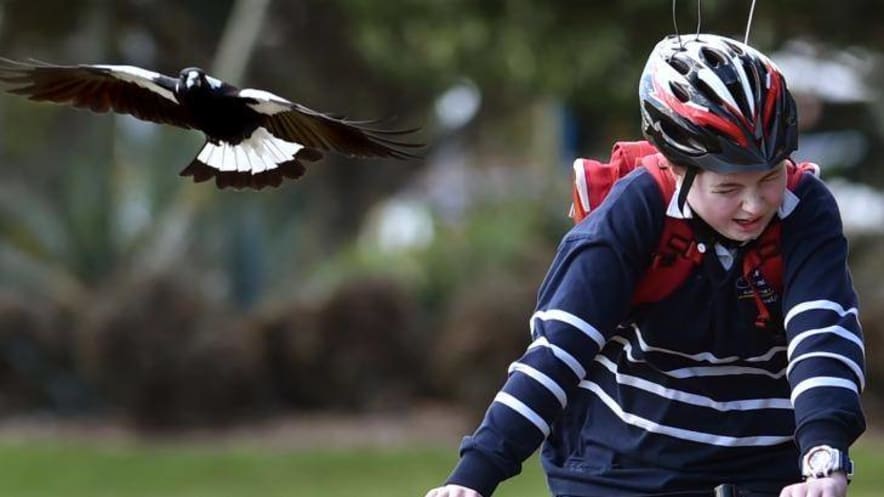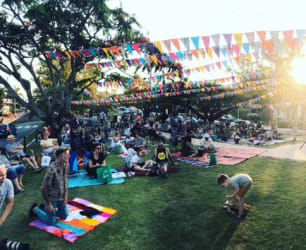We're taking a closer look at our dear little Aussie frenemy, the humble Magpie: What they're about, why they swoop and the best ways to avoid being on the receiving end of a flying beak this Spring.
It would be safe to say that most Aussies have had the crap scared out of them by a magpie swooping at some point in their lives and have been left wondering what the hell just happened. Some of us even have the head scars to prove it!
For most of the year, the Australian Magpie (Gymnorhina tibicen) is a tame territorial bird and an instantly recognisable part of the Australian landscape, delighting all with its melodious warble.
Some people have even made friends with curious magpies, but come springtime, it is not uncommon for some local parks, playgrounds and neighbourhoods to become avian warzones as some of these once-tame birds go into full attack mode and target perceived threats to their young by swooping.
The instinct to protect your baby is primal and natural, and this instinct is no different in magpies. However they are not all bloodthirsty attackers they are painted to be in Spring, there is only a small percentage of dads (around 8-10 percent) who protect their babies with their terrifying body language of swooping, screeching, pecking and wing flapping. The majority of magpies go about their business raising their young without aggression.
Magpies mate for life and their mating season is usually from August to November each year. Carefully constructed nests containing their young are positioned in outer branches of trees up to 15m above the ground. The protective magpie dads go into overdrive to defend their nests, from the time the eggs are laid to the time the young fledglings leave, attacking anything they perceive as a threat, from dogs to humans.
Generally, magpies will swoop within 50 metres of their nests, and because they are territorial will go back to the same spots year after year. So, if your favourite walk, bike ride or skate is in the middle of a magpie nesting area and you are being swooped, it will most likely be a magpie attacking hotspot next year too. If you can take an alternate route until the end of mating season in November, life will be less pecked.
If that is not possible, we have some tips from Magpie Alert to help prevent you from being swooped during magpie mating season.
- Keep alert and pay attention for any magpie nesting sites.
- Travel in groups where possible as the birds often target individuals.
- Keep an ear open for their distinctive calls.
- Wear sunglasses and with a hat to protect your head and eyes.
- If a magpie swoops while you are cycling, it will probably stop swooping if you get off your bike and walk.
- If you spot a magpie nesting site then stay well clear and even plan alternative routes.
- Remember magpies are urban species too, so there is generally no escaping them.
- If you get swooped then tell others, log the attack here on Magpie Alert and inform your local council.
- Do not provoke the magpies, they are very territorial and will protect their nests.
- Wear a wide-brimmed hat or carry an umbrella.
- It is important to try to stay calm, if you panic and flap then this is more likely to appear as aggressive behaviour and provoke a further attack.
- Face the magpie - they tend to attack from behind so facing them should avert an attack.
- Magpies seem to have very good memories and have attacked the same people over subsequent seasons and others they just leave alone. If it's attacked you before probably a good idea to use an alternative route next season.
Here are also some Pro Birdwatching tips from local birder and member of Birdlife Australia, Greg Smith:
How to spot a magpie’s nest
Look to the outer branches of the trees for oval clumps of loose sticks and twigs sometimes with manmade items such as wire incorporated into them. Only 8 to 10 percent of magpies actually swoop. The majority quietly go about the business of nesting and raising young without aggression. Please don’t disturb or agitate the parent birds or you may create another swooper and bear in mind they have very good memories and utilise facial recognition to identify individual humans as a friend or potential foe.
Magpies can be distinguished by the feathers on their backs, males are white, females are grey and speckled and baby magpies are mostly grey and speckled.
Rescuing baby magpies
If you see a baby magpie on the ground, please don’t immediately rush to save it. Fledgling magpies will leave the nest before their tail feathers are fully grown and live on the ground protected by their parents. The parents can swoop during the day and hide them in undergrowth at night. Crow and Currawong young do the same. Many people find the fledglings, think they are abandoned, then rescue them taking them to a vet or an animal hospital. Before you do a rescue, watch the fledgling for a short time and if the parents are checking in on the bird then it is ok to leave things alone.
If the bird is in immediate danger or injured then of course intervene. In this case, the best option would be to contact a local wildlife rescue organisation such as Wildcare Australia or Currumbin Wildlife Sanctuary here on the Gold Coast.






